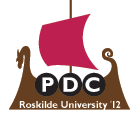| PAPERS | WEDNESDAY 11:00-12:30 | GRAND AUDITORIUM |
Users' Roles
Session chair: Sisse Finken, Oslo University
Personas, people and participation: Challenges from the trenches of local government
Susanne Bødker, Aarhus University
Ellen Christiansen, Aalborg University
Tom Nyvang, Aalborg University
Pär-Ola Zander, Aalborg University
Abstract. In the early days of digital technology development, design was done ‘for’, ‘with’ or ‘by’ the users based on the assumption that users were real people. Today ‘users’ have become a component in mass-market production and are seen as ‘customers’, rather than people. Still designers need to address use, and personas have been introduced for this purpose. The paper uses re-search on user participation and research-based personas from the eGov+ project to discuss whether personas help designers engage with users. In this project, design was carried out in the domain of municipal services through involvement of clerks, management and citizens from three different municipalities. Through four cases we discuss if applying personas in participatory design settings is productive to designers’ understanding of users’ use situations. Does deployment of personas bring designers closer to the actual use situation? In which ways do personas help design for, with or by the users? Do personas support participatory design?
Imagine real avatars and flying shepherds: Involvement and engagement in innovative ICT
Steve Walker, The Open University
Simon Bell, The Open University
Adrian Jackson, The Open University
Daniel Heery, Cybermoor Services Ltd
Abstract. This paper takes as its starting point Kyng’s (2010) challenges for future participatory design practices in the context of a technology landscape which has changed enormously since the emergence of both ‘Scandinavian’ PD and the participatory politics of 1960s US radicalism. We describe the Infinite Bandwidth, Zero Latency (IBZL)) project, from its use of the ‘Imagine’ workshop method to envisage potential technological futures, through to its involvement of stakeholder representatives and potential users in assessing one such vision of potential technological ‘futures’, the ‘real avatar’’. IBZL was originally conceived as an intervention in policy debates in the UK about the significance and potential of ‘next generation’ or ‘superfast’ broadband networks, and as a way of mobilizing wider audiences to consider the possibility of innovative applications of them. By their very nature, the significance of these networks transcends particular workplaces. This case study describes responses to several of the challenges for PD practice raised by Kyng, including the roles of companies, intellectual property, funding, the involvement of social actors as users, the engagement of users in multiple roles.
A small matter of design - An analysis of end users as designers
Anne Marie Kanstrup, Aalborg University
Abstract. The paper presents an analysis of end user design in a PD project exploring user-driven innovation as a perspective and method for PD. End user designs are analysed in relation to existing perspectives on innovative design. End users work as designers are analysed in relation to existing perspectives on what it means to be a reflective designer. A series of examples present end users as competent designers and additionally emphasize the understanding of end user design as more than design of innovative products and functionality – end user design is characterised as inquiry and negotiations of disparate logics and results in expressions that call for engaging in communication. It is concluded that the fundamental goal of PD as “giving voice” to end users has not changed or become less important despite new media platforms and business appreciations of user-drive. Rather, it is important for PD to elaborate how to hear and understand end user voices by supporting user negotiations and inquiries and engaging in partly unconscious communication of expressions beyond functionality.
